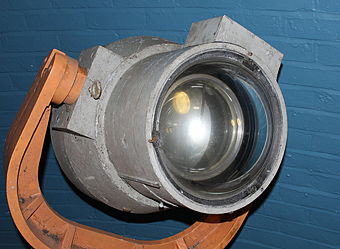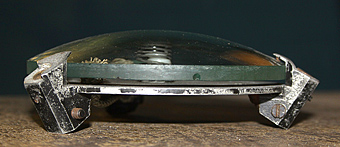The meniscus Super-Schmidt meteor camera
After the second world war, the recently-developed radar was used in astronomy, including the study of meteors (meteor trails reflect radar). In the UK, Manchester University was pre-eminent in these studies, including work at Jodrell Bank (about 19 miles from Keele). In the mid 1950s, they commissioned Bristol University to design and build special wide-angle cameras, so that meteors could be photographed at the same time as radar detected them. [Report of first use at Manchester]
One of these was gifted to Keele in the 1970s, for possible modification (see below). It is sometimes called the "Super Schmidt", but maybe it should just be called the "meniscus Super-Schmidt", to distinguish it from other versions and modifications of Schmidt cameras (such as the Baker-Nunn types more common in the US). This truly is an amazing bit of kit. In ordinary photographic teminology, it has an f-ratio of 0.8. It's field of view was just over 55 degrees. But all this comes at a cost — the photographic image plane (in those days, all cameras used film or glass plates) is very curved. For each photograph, the photographic film had to be specially curved to fit a glass plate as seen in the right-hand picture below.

|

|
| The camera (needing its paint restored) Larger image |
The photographic plate; note the extreme curvature Larger image |
Dr Maddison proposed to use a fibre-optic channel plate formed with such a curved surface on the front, so that the image would fall on this surface, and then be transferred to a flat back surface, where 'ordinary' (i.e. flat!) film or plates could be used. Unfortunately, he was unable to obtain money to do this (such fibre optics devices were very expensive at that time), so this very interesting project could not be pursued. [It wouldn't be so expensive today, but getting a wide-angle star photograph is rather easier these days: just use a modern electronic camera and wide-angle lens.]
So Keele has this very historic instrument (only three or four were ever made). It was truly cutting-edge in a world sense 50 years ago. One interesting story (possibly just a rumour) is that this camera was used to take one of the first photographs of an artificial satellite (Sputnik) in 1957 ( Sputnik report, Jodrell Bank's role in early space tracking activities).

